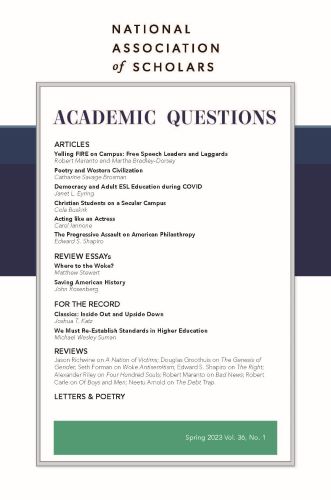Four Hundred Souls: A Community History of African America, 1619-2019, eds. Ibram X. Kendi, Keisha N. Blain, 2021, One World, pp. 528, $14.60 hardcover.
Alexander Riley is Professor of Sociology at Bucknell University whose latest books include Toward a Biosocial Science: Evolutionary Theory, Human Nature, and Social Life (Taylor and Francis, 2021) and Reflecting on the 1960s at 50 (Routledge, 2021); [email protected]. Riley last appeared in AQ in summer 2022 with “Cormac McCarthy: Conservative Novelist.”
In The Genealogy of Morals, Nietzsche describes the “squint” of the individual damaged by the psychopathology he named with the French word ressentiment. Those whose attitude is governed by this malady understand their identities only as reflected through some entity outside themselves, which is believed to malignly dominate every element of their sense of self. The perceived tormentor causes all misfortune in their lives. By contrast, the self-directed forget enemies, or even cherish them as the means for expressing their own worth in struggle. At the core of those filled with ressentiment is nothing more than a burning hatred for the Other who prevents the self from emerging. Nietzsche notes that this is a phenomenon not restricted to any particular political orientation. The anarchist and the antisemite share this inability to assert identity without first establishing the evil antagonist and then eternally screaming a reactionary “No!” at it.
Nietzsche turns out to be an excellent interpretive framework for works such as Four Hundred Souls.
Ressentiment is the frame of Kendi’s introduction. “There is no better word than ‘we,’” he writes. This glorious collective “us” defines the black condition. But opposed to this wondrous we is a hateful and hated them: “Racist power constructed the Black race. Them . . . Them constructed, again and again.”
The book’s foundation is that of the New York Times’s 1619 Project. That is the year of the founding of America in the antiracist mythology, so here ninety writers take on five-year chunks of the four centuries of black suffering. Many are journalists with no scholarly expertise in the topics they discuss. Two of the most common job descriptions of contributors are “professor of Africana Studies” and “activist,” which amounts to the same thing. Nikole Hannah-Jones, the head mythologist of the Times’s revisionist effort, opens the collection predictably: “The true story of America begins here, in 1619 . . . We must not flinch.”
What follows is the continuous sounding of one boring note. It has been four hundred years of endless affliction and terror meted out by an unchanging and unlimited power of demonic fury utterly bent on the elimination of all things non-white.
Ijeoma Oluo presents her biracial identity in the context of an early seventeenth century case of a white man punished for sleeping with a black woman. “I am black because I have no choice but to be,” she proclaims. Later, she alludes to charges that she has incorporated the same unbreachable walls separating racial groups presented by historical white supremacy in her own self-conception, but Oluo predictably fails to see the accusation’s accuracy. She is indistinguishable from her enemies, who in 2023 mostly do not even do her the favor of existing, outside of her own imagination.
The reader is informed of the rather odd news that the American Revolution and the production of the country’s founding documents were racist non-events because they did not immediately end slavery. In another chapter, we learn that Christianity in the United States was “a cornerstone of white supremacy.” The fact that abolitionism drew heavily upon the Christian moral worldview from its beginnings to the successful elimination of slavery is swept away as an irrelevant detail.
Many of the book’s offerings are incoherence itself. Raquel Willis tells us in several clumsily written pages that fugitive black slaves sometimes took on identities not their own to escape detection by authorities. It is claimed this is somehow connected in salient ways to “sexually fluid behaviors in Central Africa” and black prostitutes who stole money from clients. All of which (of course!) points to the existence of lots of “Black queer folks” in the United States of the early 1800s.
One writer uses the term ”proto-intersectionality” to describe her painstaking effort to read the past through the preferred lens of the current crop of sexually anarchic activists. In this view, nearly all black female writers have seen the world through the fractionating lunacies of contemporary identity politics. No black female writer ever anywhere was capable of conceiving of herself as a human being who shared the most basic elements of her experience and emotion with all other human beings. The end of slavery too must never be understood as a conclusion of a sordid chapter and an introduction to a new and uplifting story of integration of those formerly excluded into the existing society. It can only be viewed as a prelude to other seismic changes that inevitably follow—the end of capitalism, then the magical appearance of sexual and gender utopia in which all formerly solid categories melt into thin air.
The Dred Scott decision is described as the most “revealing and defining event . . . [in] American history . . . the fulcrum of American identity.” The author of this piece, John Powell, believes the “overturning [of this decision] is an ongoing and incomplete project.” Someone might perhaps want to deliver him the news of the Emancipation Proclamation and the Thirteenth, Fourteenth, and Fifteenth Amendments.
The author of the four pages given to the Civil War is Jamelle Bouie, a journalist with no advanced academic degree. He insinuates that black soldiers were a determining force in the war. Without them, the Civil War would only have been “a war for union” instead of a “war for emancipation.” The 180,000 blacks he describes fighting in thirty-nine engagements constituted around five percent of the more than three million soldiers who fought, and they engaged in well under a third of the war’s 150 or so significant battles. Yet somehow this level of participation constitutes a “critical, world-historical part in driving” the war’s conclusion.
The Enlightenment is presented as a cover for pseudo-scientific exclusion of blacks. One of its American exponents, Ben Franklin, is painted as an unrepentant enemy of black freedom because he had owned slaves and he believed that the country’s European-origin majority should be maintained. There is no mention of the fact that the mature Franklin believed black underdevelopment stemmed not from natural inferiority but from their conditions under slavery and that this could be ameliorated through education. It also escapes the author’s notice that Franklin’s “partiality” to his race, which he described as “natural to Mankind,” is the same high self-regard every writer in this tome expresses in talking of the superior black moral sensibility and courageous ability to bear repression.
Black music is an expression of ressentiment too. A chapter on hip hop culture seamlessly solders all rap music to the bitter anger of Malcolm X and the expressly anti-white, black supremacist rantings of the Five Percent Nation and the Nation of Islam. The book has no index entry for “blues” or “jazz,” nor for any of the great musical figures in those two consummately American genres brought forth by black creative invention.
There is also no index item for the Southern Christian Leadership Conference, the group headed by Martin Luther King, Jr. that was responsible for the most socially productive and morally appealing parts of the protest movement of the 1950s and 1960s. It is mentioned in one chapter, but only to be denounced as “male supremacist” and too convinced that hierarchical leadership is necessary in church. The chapter’s author cheers for excitable black youth striking out on their own in SNCC and CORE, both of which collapsed into a revolutionary, black nationalist hole.
A chapter on Black Power lauds the “daring blend of revolutionary politics” of the Black Panthers. No mention is made of the several killings Panther leader Huey Newton carried out himself or ordered committed by other members of his criminal gang. Nothing either on the still more murderous Panther splinter group of the 1970s, the Black Liberation Army, which conducted a decade long terrorist campaign of bombings and police assassinations.
What else? Prisons must go and laws cannot be enforced because blacks are disproportionately affected. White supremacy is stealing the black vote by asking that people show IDs at the polling place. Black Lives Matter, which led major riots in many cities—costing many millions and killing innocents—and started a movement to end policing that led to a spike in violent crime in poor black communities, is peaceful and just. The lament of the last chapters is: “We are still coming up short . . . the problem [of white supremacy] is still with us.”
It would be one thing if the proposed readership of a volume like this were, in the schools where there will certainly be efforts to promote it, also given histories dedicated to complex truths and inconvenient facts to which to compare it. That is unlikely, but it would at least give students an indication of how predictable and monomaniacal these writers are.
Any objective history of black America must acknowledge how fundamentally their condition has been transformed in four-hundred years. Such a history would be complex, even apparently contradictory, and vivid with rich empirical detail. A commitment to truth in the history of black America would require looking hard at unpleasant chapters, certainly, but it would also recognize the undeniable, constant upward arc of the status of blacks. It would endeavor to describe how that arc has been influenced both by black accomplishment and by the ways in which the broader American culture has changed to facilitate their rise. A collection such as this, in which the lives of blacks are forever and always warped and handicapped by eternally malevolent forces beyond their control, is not history but ideologically-motivated fiction.
Photo by Andrii on Adobe Stock













